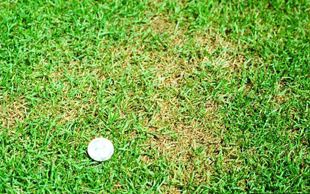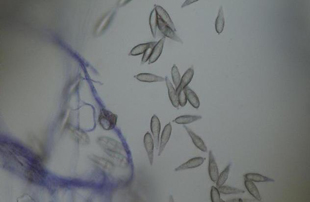G1916
Gray Leaf Spot of Turf
Gray leaf spot can occur in turf in late summer. This NebGuide describes the disease and how to identify and manage it.
Loren J. Giesler, Extension Plant Pathologist
- Introduction
- Cause, Hosts, and Occurrence
- Key Symptoms
- Cultural/Maintenance Practices
- Fungicide Program
Introduction
Gray leaf spot is a disease that usually occurs in late summer during periods of hot and humid weather. The disease affects large areas of perennial ryegrass or tall fescue (Figure 1). It is most common in golf course fairways and roughs or athletic fields. It can be especially severe in newly seeded stands of perennial ryegrass or tall fescue. The potential for disease development can be reduced by implementing several cultural practices. Fungicides are also effective in controlling this disease. The following information describes the disease and how to identify and manage it.
Cause, Hosts, and Occurrence
Cause: Pyricularia grisea (Figure 2)
Primary Hosts: Perennial ryegrass and tall fescue
Occurrence: August-September
Favorable conditions: Extended periods of warm (70-95°F) weather during August; extended periods of leaf wetness (14 hours required to initiate disease development).
 |
 |
|
| Figure 1. Gray leaf spot on perennial ryegrass. (Photo courtesy of D. Settle, Bugwood.org) | Figure 2. Microscopic view of Pyricularia grisea conidia. (Photo courtesy of P. Bachi, Bugwood.org) |
Key Symptoms
- Rapid dying of taller turf during warm, humid weather in August.
- Presence of twisted leaves that resemble a fish hook.
- Water-soaked lesions on leaf blades.
- Blighted leaves appear matted and greasy.
- Under conditions of moisture or high humidity, leaves will turn gray and be fuzzy with heavy sporulation.
- Can be confused with Pythium blight.
Cultural/Maintenance Practices
- Use resistant cultivars.
- Mow turf using the “1/3 rule” to avoid stress and collect clippings when disease is active.
- Avoid late afternoon or nighttime irrigation; water in early morning.
- Avoid stress of any kind that will favor disease development. Do not apply herbicides or growth regulators during warm, humid weather.
Fungicide Program
Fungicides for gray leaf spot management are presented in Table I. Product examples are provided for each active ingredient, but not all products are listed. Commercial product labels will have a section that provides a list of active ingredients.
While the active ingredient may be in combination with others, users should look for a specific active ingredient with or without other chemistry modes of action.
A preventive fungicide program is recommended for new seedings or overseeded areas of perennial ryegrass in areas with a history of gray leaf spot.
Fungicides listed represent the best information available. Read and follow all product label directions for mixing and application.
| Table I. Fungicides for Control of Gray Leaf Spot in Turf1 | ||||
Fungicide |
Fungicide Class |
Interval (Days) |
Efficacy2 |
Product Names |
Azoxystrobin |
Strobilurin |
14-21 |
4 |
Heritage® |
Chlorothalonil |
Chloronitrile |
7-10 |
2+ |
Daconil Ultrex®3 |
Fluoxastrobin |
Strobilurin |
14-28 |
L |
Disarm® |
Mancozeb |
Dithiocarbamate |
14 |
2 |
Fore® |
Mancozeb + chlorothalonil |
Dithiocarbamate + Chloronitrile |
14 |
3 |
Fore® Rainshield® + Daconil Ultrex® |
Metconazole |
DMI4 |
14 |
2 |
Tourney® |
Mineral oil |
Not Classified |
7-21 |
2 |
Civitas™ |
Myclobutanil + mancozeb |
DMI + dithiocarbamate |
14 |
3 |
MANhandle® |
Polyoxin D |
Polyoxin |
7-14 |
1 |
Endorse® |
Propiconazole |
DMI |
14 |
2 |
Banner® Maxx®3 |
Propiconazole + chlorothalonil |
DMI + chloronitrile |
14 |
3 |
Banner® Maxx® + Daconil Ultrex® |
Pyraclostrobin |
Strobilurin |
14-28 |
4 |
Insignia® |
Tebuconazole |
DMI |
28 |
L |
Torque™ |
Thiophanate-methyl |
MBC4 |
7-14 |
4 |
Cleary’s 3336®3 |
Triadimefon |
DMI |
14 |
2 |
Bayleton® 50 |
Triadimefon + chlorothalonil |
DMI + chloronitrile |
14 |
3 |
Bayleton® 50 + Daconil Ultrex® |
Trifloxystrobin |
Strobilurin |
14-21 |
3+ |
Compass® |
1Fungicide active ingredients, class, and efficacy ratings for products labeled for the control of gray leaf spot. Table adapted from P. Vincelli and D.W. Williams, Chemical Control of Turfgrass Diseases 2011, University of Kentucky Cooperative Extension Service.
2Rating system: 4 = consistently good control; 3 = good to excellent control; 2 = fair to good control; 1 = control is inconsistent but performs well in some instances; L = limited published data on effectiveness; + = intermediate between two efficacy categories. 3Other products with the same active ingredient may be available. 4DMI fungicides are demethylation inhibitors and are otherwise known as Triazole fungicides. MBC = Methyl Benzimidazole Carbamate. |
||||
This publication has been peer reviewed.
Disclaimer Reference to commercial products or trade names is made with the understanding that no discrimination is intended of those not mentioned and no endorsement by University of Nebraska–Lincoln Extension is implied for those mentioned. |
Visit the University of Nebraska–Lincoln Extension Publications website for more publications.
Index: Plant Diseases
Turf
Issued July 2011